《DSP using MATLAB》Problem 7.28
又是一年五一节,朋友圈都是晒名山大川的,晒脑袋的,我这没钱的待在家里上网转转吧


频率采样法设计带通滤波器,过渡带中有一个样点
代码:
%% ++++++++++++++++++++++++++++++++++++++++++++++++++++++++++++++++++++++++++++++++
%% Output Info about this m-file
fprintf('\n***********************************************************\n');
fprintf(' <DSP using MATLAB> Problem 7.28 \n\n'); banner();
%% ++++++++++++++++++++++++++++++++++++++++++++++++++++++++++++++++++++++++++++++++ % bandpass
ws1 = 0.3*pi; wp1 = 0.4*pi; wp2 = 0.6*pi; ws2 = 0.7*pi; As = 40; Rp = 0.5;
tr_width = min((wp1-ws1), (ws2-wp2)); T1=0.39;
M = 40; alpha = (M-1)/2; l = 0:M-1; wl = (2*pi/M)*l;
n = [0:1:M-1]; wc1 = (ws1+wp1)/2; wc2 = (wp2+ws2)/2; Hrs = [zeros(1,7),T1,ones(1,5),T1,zeros(1,13),T1,ones(1,5),T1,zeros(1,6)]; % Ideal Amp Res sampled
Hdr = [0, 0, 1, 1, 0, 0]; wdl = [0, 0.3, 0.4, 0.6, 0.7, 1]; % Ideal Amp Res for plotting
k1 = 0:floor((M-1)/2); k2 = floor((M-1)/2)+1:M-1; %% --------------------------------------------------
%% Type-2 BPF
%% --------------------------------------------------
angH = [-alpha*(2*pi)/M*k1, alpha*(2*pi)/M*(M-k2)];
H = Hrs.*exp(j*angH); h = real(ifft(H, M)); [db, mag, pha, grd, w] = freqz_m(h, [1]); delta_w = 2*pi/1000;
%[Hr,ww,P,L] = ampl_res(h);
[Hr, ww, a, L] = Hr_Type2(h); Rp = -(min(db(floor(wp1/delta_w)+1 :1: floor(wp2/delta_w)))); % Actual Passband Ripple
fprintf('\nActual Passband Ripple is %.4f dB.\n', Rp); As = -round(max(db(ws2/delta_w+1 : 1 : 501))); % Min Stopband attenuation
fprintf('\nMin Stopband attenuation is %.4f dB.\n', As); [delta1, delta2] = db2delta(Rp, As) % Plot figure('NumberTitle', 'off', 'Name', 'Problem 7.28a FreSamp Method')
set(gcf,'Color','white');
subplot(2,2,1); plot(wl(1:21)/pi, Hrs(1:21), 'o', wdl, Hdr, 'r'); axis([0, 1, -0.1, 1.1]);
set(gca,'YTickMode','manual','YTick',[0,0.5,1]);
set(gca,'XTickMode','manual','XTick',[0,0.3,0.4,0.6,0.7,1]);
xlabel('frequency in \pi nuits'); ylabel('Hr(k)'); title('Frequency Samples: M=40,T1=0.39');
grid on; subplot(2,2,2); stem(l, h); axis([-1, M, -0.2, 0.3]); grid on;
xlabel('n'); ylabel('h(n)'); title('Impulse Response(Type-2)'); subplot(2,2,3); plot(ww/pi, Hr, 'r', wl(1:21)/pi, Hrs(1:21), 'o'); axis([0, 1, -0.2, 1.2]); grid on;
xlabel('frequency in \pi units'); ylabel('Hr(w)'); title('Amplitude Response');
set(gca,'YTickMode','manual','YTick',[0,0.5,1]);
set(gca,'XTickMode','manual','XTick',[0,0.3,0.4,0.6,0.7,1]); subplot(2,2,4); plot(w/pi, db); axis([0, 1, -100, 10]); grid on;
xlabel('frequency in \pi units'); ylabel('Decibels'); title('Magnitude Response');
set(gca,'YTickMode','manual','YTick',[-90,-40,0]);
set(gca,'YTickLabelMode','manual','YTickLabel',['90';'40';' 0']);
set(gca,'XTickMode','manual','XTick',[0,0.3,0.4,0.6,0.7,1]); figure('NumberTitle', 'off', 'Name', 'Problem 7.28 h(n) FreSamp Method')
set(gcf,'Color','white'); subplot(2,2,1); plot(w/pi, db); grid on; axis([0 2 -120 10]);
set(gca,'YTickMode','manual','YTick',[-90,-40,0])
set(gca,'YTickLabelMode','manual','YTickLabel',['90';'40';' 0']);
set(gca,'XTickMode','manual','XTick',[0,0.3,0.4,0.6,0.7,1,1.3,1.4,1.6,1.7,2]);
xlabel('frequency in \pi units'); ylabel('Decibels'); title('Magnitude Response in dB'); subplot(2,2,3); plot(w/pi, mag); grid on; %axis([0 1 -100 10]);
xlabel('frequency in \pi units'); ylabel('Absolute'); title('Magnitude Response in absolute');
set(gca,'XTickMode','manual','XTick',[0,0.3,0.4,0.6,0.7,1,1.3,1.4,1.6,1.7,2]);
set(gca,'YTickMode','manual','YTick',[0,1.0]); subplot(2,2,2); plot(w/pi, pha); grid on; %axis([0 1 -100 10]);
xlabel('frequency in \pi units'); ylabel('Rad'); title('Phase Response in Radians');
subplot(2,2,4); plot(w/pi, grd*pi/180); grid on; %axis([0 1 -100 10]);
xlabel('frequency in \pi units'); ylabel('Rad'); title('Group Delay'); figure('NumberTitle', 'off', 'Name', 'Problem 7.28 AmpRes of h(n), FreSamp Method')
set(gcf,'Color','white'); plot(ww/pi, Hr); grid on; %axis([0 1 -100 10]);
xlabel('frequency in \pi units'); ylabel('Hr'); title('Amplitude Response');
set(gca,'YTickMode','manual','YTick',[-delta2, 0,delta2, 1-delta1, 1,1+delta1]);
%set(gca,'YTickLabelMode','manual','YTickLabel',['90';'40';' 0']);
set(gca,'XTickMode','manual','XTick',[0,0.3,0.4,0.6,0.7,1]); %% ------------------------------------
%% fir2 Method
%% ------------------------------------
f = [0 ws1 wp1 wp2 ws2 pi]/pi;
m = [0 0 1 1 0 0];
h_check = fir2(M-1, f, m); % order
[db, mag, pha, grd, w] = freqz_m(h_check, [1]);
%[Hr,ww,P,L] = ampl_res(h_check);
[Hr, ww, a, L] = Hr_Type2(h_check); fprintf('\n----------------------------------\n');
fprintf('\n fir2 function Method \n');
fprintf('\n----------------------------------\n'); Rp = -(min(db(floor(wp1/delta_w)+1 :1: floor(wp2/delta_w)))); % Actual Passband Ripple
fprintf('\nActual Passband Ripple is %.4f dB.\n', Rp);
As = -round(max(db(0.75*pi/delta_w+1 : 1 : 501))); % Min Stopband attenuation
fprintf('\nMin Stopband attenuation is %.4f dB.\n', As); [delta1, delta2] = db2delta(Rp, As) figure('NumberTitle', 'off', 'Name', 'Problem 7.28 fir2 Method')
set(gcf,'Color','white'); subplot(2,2,1); stem(n, h); axis([0 M-1 -0.2 0.3]); grid on;
xlabel('n'); ylabel('h(n)'); title('Impulse Response'); %subplot(2,2,2); stem(n, w_ham); axis([0 M-1 0 1.1]); grid on;
%xlabel('n'); ylabel('w(n)'); title('Hamming Window'); subplot(2,2,3); stem([0:M-1], h_check); axis([0 M-1 -0.2 0.3]); grid on;
xlabel('n'); ylabel('h\_check(n)'); title('Actual Impulse Response'); subplot(2,2,4); plot(w/pi, db); axis([0 1 -120 10]); grid on;
set(gca,'YTickMode','manual','YTick',[-90,-61,-17,0])
set(gca,'YTickLabelMode','manual','YTickLabel',['90';'61';'17';' 0']);
set(gca,'XTickMode','manual','XTick',[0,0.3,0.4,0.6,0.7,1]);
xlabel('frequency in \pi units'); ylabel('Decibels'); title('Magnitude Response in dB'); figure('NumberTitle', 'off', 'Name', 'Problem 7.28 h(n) fir2 Method')
set(gcf,'Color','white'); subplot(2,2,1); plot(w/pi, db); grid on; axis([0 2 -120 10]);
xlabel('frequency in \pi units'); ylabel('Decibels'); title('Magnitude Response in dB');
set(gca,'YTickMode','manual','YTick',[-90,-61,-17,0]);
set(gca,'YTickLabelMode','manual','YTickLabel',['90';'61';'17';' 0']);
set(gca,'XTickMode','manual','XTick',[0,0.3,0.4,0.6,0.7,1,1.3,1.4,1.6,1.7,2]); subplot(2,2,3); plot(w/pi, mag); grid on; %axis([0 1 -100 10]);
xlabel('frequency in \pi units'); ylabel('Absolute'); title('Magnitude Response in absolute');
set(gca,'XTickMode','manual','XTick',[0,0.3,0.4,0.6,0.7,1,1.3,1.4,1.6,1.7,2]);
set(gca,'YTickMode','manual','YTick',[0,1.0]); subplot(2,2,2); plot(w/pi, pha); grid on; %axis([0 1 -100 10]);
xlabel('frequency in \pi units'); ylabel('Rad'); title('Phase Response in Radians');
subplot(2,2,4); plot(w/pi, grd*pi/180); grid on; %axis([0 1 -100 10]);
xlabel('frequency in \pi units'); ylabel('Rad'); title('Group Delay'); figure('NumberTitle', 'off', 'Name', 'Problem 7.28 AmpRes of h(n),fir2 Method')
set(gcf,'Color','white'); plot(ww/pi, Hr); grid on; %axis([0 1 -100 10]);
xlabel('frequency in \pi units'); ylabel('Hr'); title('Amplitude Response');
set(gca,'YTickMode','manual','YTick',[-delta2, 0,delta2, 1-delta1, 1,1+delta1]);
%set(gca,'YTickLabelMode','manual','YTickLabel',['90';'45';' 0']);
set(gca,'XTickMode','manual','XTick',[0,0.3,0.4,0.6,0.7,1]);
运行结果:
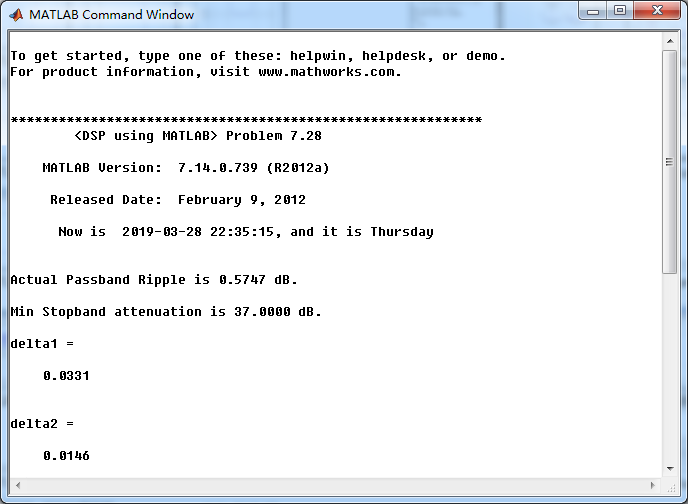
频率采样法,得到的脉冲响应、振幅响应和幅度响应:
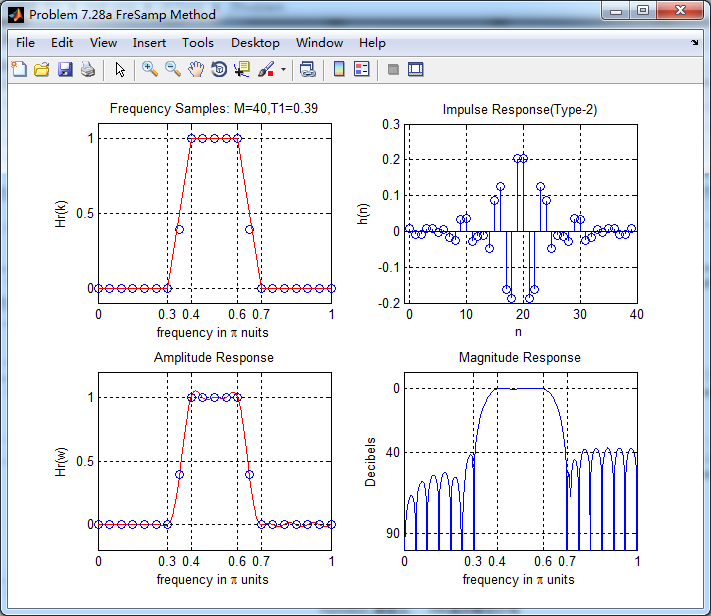
幅度响应、相位响应和群延迟
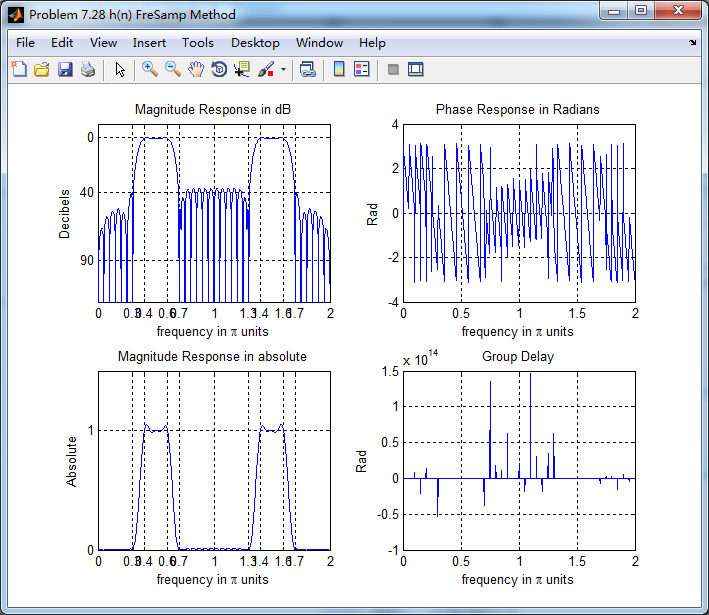
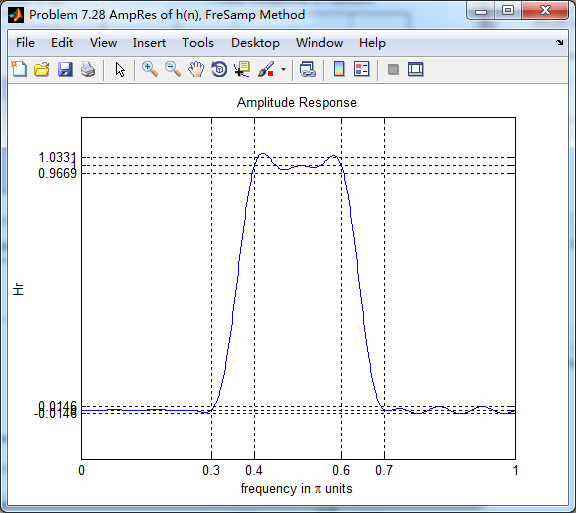
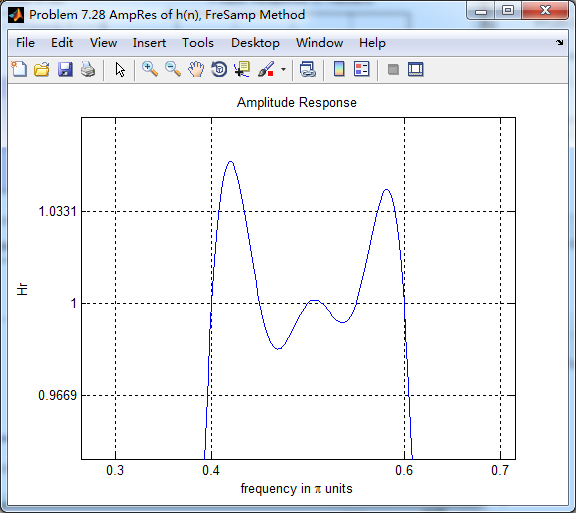
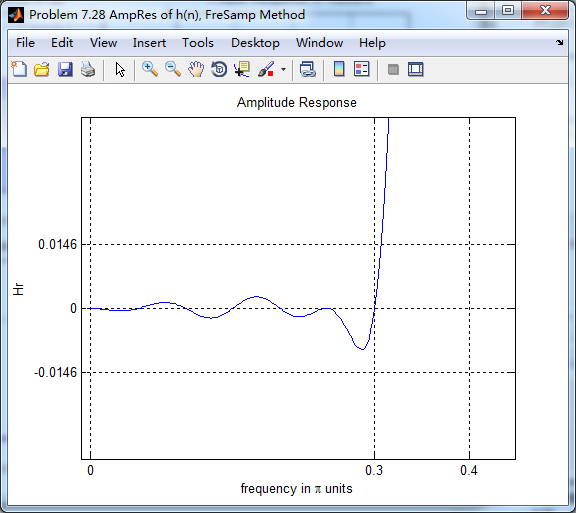
采用fir2函数求脉冲响应序列
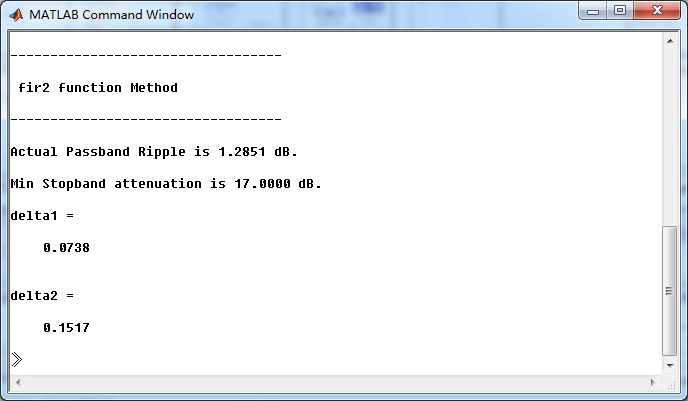

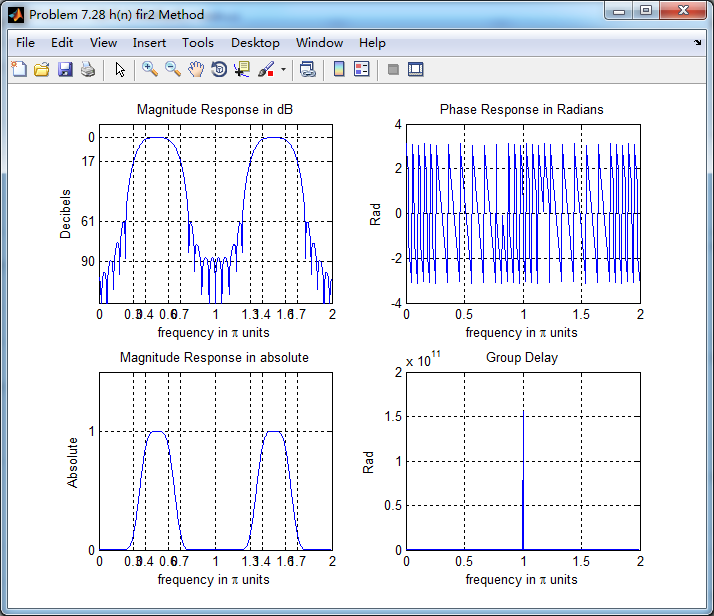
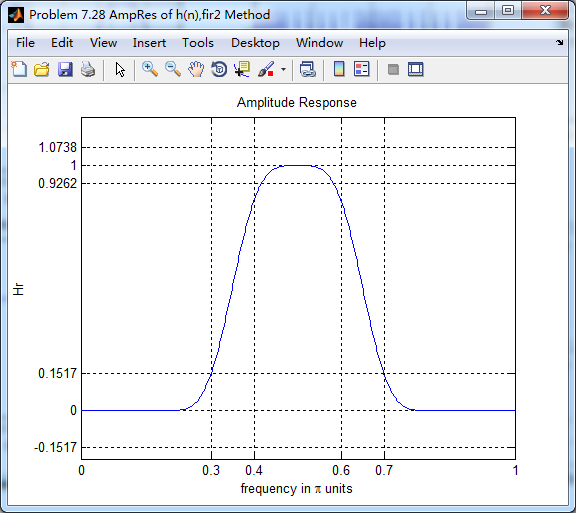
matlab自带的fir2函数比频率采样法得到的脉冲响应,通带和阻带的波纹ripple较小。
《DSP using MATLAB》Problem 7.28的更多相关文章
- 《DSP using MATLAB》Problem 5.28
昨晚手机在看X信的时候突然黑屏,开机重启都没反应,今天维修师傅说使用时间太长了,还是买个新的吧,心疼银子啊! 这里只放前两个小题的图. 代码: 1. %% ++++++++++++++++++++++ ...
- 《DSP using MATLAB》Problem 8.28
代码: %% ------------------------------------------------------------------------ %% Output Info about ...
- 《DSP using MATLAB》Problem 7.36
代码: %% ++++++++++++++++++++++++++++++++++++++++++++++++++++++++++++++++++++++++++++++++ %% Output In ...
- 《DSP using MATLAB》Problem 7.27
代码: %% ++++++++++++++++++++++++++++++++++++++++++++++++++++++++++++++++++++++++++++++++ %% Output In ...
- 《DSP using MATLAB》Problem 7.26
注意:高通的线性相位FIR滤波器,不能是第2类,所以其长度必须为奇数.这里取M=31,过渡带里采样值抄书上的. 代码: %% +++++++++++++++++++++++++++++++++++++ ...
- 《DSP using MATLAB》Problem 7.25
代码: %% ++++++++++++++++++++++++++++++++++++++++++++++++++++++++++++++++++++++++++++++++ %% Output In ...
- 《DSP using MATLAB》Problem 7.24
又到清明时节,…… 注意:带阻滤波器不能用第2类线性相位滤波器实现,我们采用第1类,长度为基数,选M=61 代码: %% +++++++++++++++++++++++++++++++++++++++ ...
- 《DSP using MATLAB》Problem 7.23
%% ++++++++++++++++++++++++++++++++++++++++++++++++++++++++++++++++++++++++++++++++ %% Output Info a ...
- 《DSP using MATLAB》Problem 7.16
使用一种固定窗函数法设计带通滤波器. 代码: %% ++++++++++++++++++++++++++++++++++++++++++++++++++++++++++++++++++++++++++ ...
随机推荐
- 云-腾讯云-笔记:pom.xml 配置
ylbtech-云-腾讯云-笔记:pom.xml 配置 1. pom.xml返回顶部 1.1 com.qcloud / 腾讯云 <!-- https://mvnrepository.com/ar ...
- django2 rest_framework + vue.js + mysql5.6 实现增删改查
1.安装pymysql,mysqlclient,创建项目django-admin startproject django3 2.在Mysql中创建一个数据库叫django3db,打开项目,修改一下数据 ...
- iOS开发之SceneKit框架--SCNScene.h
1.SCNScene SCNScene是一个场景图——具有附加几何形状.光照.摄像机和其他属性的节点的层次结构,共同形成可显示的3D场景. 2.相关API简介 初始化方法 //懒加载 + (insta ...
- Spring IOC基础回顾 — 组件扫描和装配
目录 注解形式配置应用IOC 1. 组件自动扫描 2. 组件依赖:为bean添加注解,实现自动注入 3. Spring IOC应用小结 注解形式配置应用IOC 在类定义.方法定义.成员变量定义前使用, ...
- 用 Docker 搭建Sha--dow--sock--s 笔记
首先得找一台海外服务器,该服务器一定要在海外. 一.在https://my.vultr.com/购买一台海外服务器,亲测选美国Miami速度最稳: 二.系统我选了CentOS 7 x64,在CentO ...
- JavaWeb读取资源文件的四种方式
1. ServletContext 1. 调用getResourcesAsStream方法获取输入流, 相对于webroot, 不用加/2. 读取任何类型的文件3. *只能在web环境下使用 Inpu ...
- 关于python程序在VS code中运行时提示文件无法找到的报错
经过测试,在设置文件夹目录时,可以找到当前目录下的htm文件,采用with open()语句可以正常执行程序,如下图. 而当未设置当前目录,直接用vscode执行该程序时,就会报错文件无法找到File ...
- 廖雪峰Java15JDBC编程-3JDBC接口-1JDBC简介
JDBC:Java DataBase Connectivity Java程序访问数据库的标准接口 使用Java程序访问数据库的时候,Java代码并不是直接通过TCP连接去访问数据库,而是通过JDBC接 ...
- SpringCloud搭建分布式配置中心(基于git)
1.简介 Spring Cloud Config.它用来为分布式系统中的基础设施和微服务提供集中化的外部配置支持,分为服务端和客户端两个部分. 其中服务端也称为分布式配置中心,他是独立的微服务应用,用 ...
- 【solr】Solr与JDK对应版本关系,Tomcat与JDK
Solr与JDK对应版本关系,Tomcat与JDK版本对应关系 最新在部署solrCloud集群,由于自己机器上用的JDK都是JDK1.7的,然后我就从网上下载了最新下载了最先的solr6.6.0和最 ...
